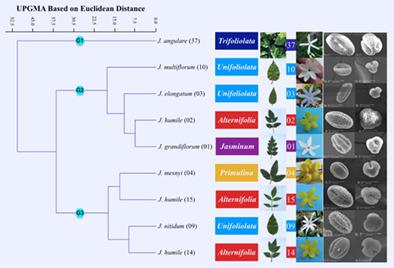当前位置:
X-MOL 学术
›
Microsc. Res. Tech.
›
论文详情
Our official English website, www.x-mol.net, welcomes your feedback! (Note: you will need to create a separate account there.)
Comparative palynology and taxonomic implication of Jasminum L. (Oleaceae) species from Pakistan on the bases of scanning electron microscopy
Microscopy Research and Technique ( IF 2.5 ) Pub Date : 2021-04-21 , DOI: 10.1002/jemt.23787 Naeem Akhtar 1 , Muhammad Qasim Hayat 2 , Ishfaq Ahmed Hafiz 1 , Nadeem Akhtar Abbasi 1 , Saad Imran Malik 3 , Umer Habib 1 , Adil Hussain 4 , Daniel Potter 5
Microscopy Research and Technique ( IF 2.5 ) Pub Date : 2021-04-21 , DOI: 10.1002/jemt.23787 Naeem Akhtar 1 , Muhammad Qasim Hayat 2 , Ishfaq Ahmed Hafiz 1 , Nadeem Akhtar Abbasi 1 , Saad Imran Malik 3 , Umer Habib 1 , Adil Hussain 4 , Daniel Potter 5
Affiliation

|
Jasminum L. is the largest genus containing ~200 species found wild mostly in the tropical regions of the world. The comparative palynological study of nine Pakistani Jasminum species with SEM showed zonocolpus, trilobate, and tricolpus pollen types with simple endocolpus apertures which are plesiomorphic and conserved in the Jasminum species. The equatorial pollen view was prolate, subprolate, and perprolate with elliptic, lobate, subcircular whereas polar view was subtriangular in all species. Few characters were specific to some species like heteropolarity in Jasminum grandiflorum and foveolate exine ornamentation with rounded heterobrochate in Jasminum angulare whereas reticulate and angular homobrochate character was common in other species. The UPGMA dendrogram based on qualitative characters did not support the phylogenetic classification of the genus Jasminum as these are highly conserved. The quantitative data showed more variation in some characters whereas few characters showed little or no variation. A greater variation in pollen size was observed among the variants of same species, for example, Jasminum humile showed highly variable polar length and equatorial diameter as compared to other species. Minimum variation was observed in colpus length which divided all species in to two groups. The large lumina were specific to Jasminum nitidum and broader muri was the prominent characteristic of Jasminum angulare. Some species like Jasminum sambac and Jasminum azoricum were unable to develop true pollen due to structural or functional disabilities. So, the quantitative characters of pollen are only suitable for palynological based grouping of Jasminum species but less suitable to infer their evolutionary relationship.
中文翻译:

基于扫描电子显微镜的巴基斯坦茉莉花(木犀科)物种的比较孢粉学和分类学意义
Jasminum L. 是最大的属,包含约 200 种,主要分布在世界热带地区。九个巴基斯坦的比较研究孢粉茉莉物种SEM显示zonocolpus,三叶,和tricolpus花粉类型的简单endocolpus孔,这些孔是祖征和保守的茉莉品种。在所有物种中,赤道花粉视图是长长的、近长的和过长的,具有椭圆形、裂片状、近圆形,而极地视图是下三角形的。一些物种特有的特征很少,例如大花茉莉的异极性和角茉莉的圆形异种花的小凹外壁纹饰而网状和有角的同型特征在其他物种中很常见。基于定性特征的 UPGMA 树状图不支持茉莉属的系统发育分类,因为它们是高度保守的。定量数据在一些性状中表现出更多的变化,而少数性状表现出很少或没有变化。在相同物种的变种中观察到花粉大小的更大差异,例如,与其他物种相比,Jasminum humile显示出高度可变的极长和赤道直径。在将所有物种分为两组的丛集长度中观察到最小变化。大管腔是Jasminum nitidum特有的,而更宽的管腔是其突出特征茉莉花。由于结构或功能障碍,一些物种如Jasminum sambac和Jasminum azoricum无法产生真正的花粉。因此,花粉的数量性状仅适用于茉莉属植物的孢粉学分组,而不太适合推断它们的进化关系。
更新日期:2021-04-21
中文翻译:

基于扫描电子显微镜的巴基斯坦茉莉花(木犀科)物种的比较孢粉学和分类学意义
Jasminum L. 是最大的属,包含约 200 种,主要分布在世界热带地区。九个巴基斯坦的比较研究孢粉茉莉物种SEM显示zonocolpus,三叶,和tricolpus花粉类型的简单endocolpus孔,这些孔是祖征和保守的茉莉品种。在所有物种中,赤道花粉视图是长长的、近长的和过长的,具有椭圆形、裂片状、近圆形,而极地视图是下三角形的。一些物种特有的特征很少,例如大花茉莉的异极性和角茉莉的圆形异种花的小凹外壁纹饰而网状和有角的同型特征在其他物种中很常见。基于定性特征的 UPGMA 树状图不支持茉莉属的系统发育分类,因为它们是高度保守的。定量数据在一些性状中表现出更多的变化,而少数性状表现出很少或没有变化。在相同物种的变种中观察到花粉大小的更大差异,例如,与其他物种相比,Jasminum humile显示出高度可变的极长和赤道直径。在将所有物种分为两组的丛集长度中观察到最小变化。大管腔是Jasminum nitidum特有的,而更宽的管腔是其突出特征茉莉花。由于结构或功能障碍,一些物种如Jasminum sambac和Jasminum azoricum无法产生真正的花粉。因此,花粉的数量性状仅适用于茉莉属植物的孢粉学分组,而不太适合推断它们的进化关系。



























 京公网安备 11010802027423号
京公网安备 11010802027423号